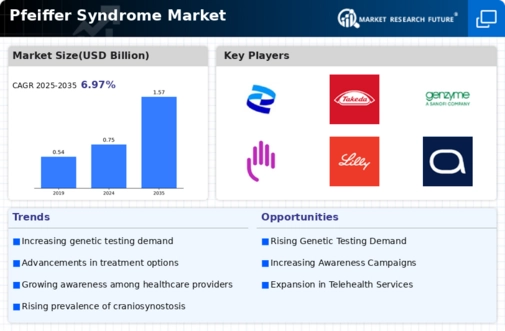The Pfeiffer Syndrome Market is characterized by a complex interplay of competitive dynamics, driven by the need for innovative therapeutic solutions and advancements in genetic research. Key players such as Genzyme Corporation (US), Pfizer Inc. (US), and Novartis AG (CH) are at the forefront, each adopting distinct strategies to enhance their market presence. Genzyme Corporation (US) focuses on developing targeted therapies, leveraging its expertise in rare diseases to create specialized treatment options. Meanwhile, Pfizer Inc. (US) emphasizes strategic partnerships and collaborations to expand its research capabilities, particularly in genetic disorders. Novartis AG (CH) is investing heavily in digital transformation initiatives, aiming to streamline its operations and improve patient engagement through technology. Collectively, these strategies contribute to a competitive environment that is increasingly centered on innovation and patient-centric solutions.
In terms of business tactics, companies are localizing manufacturing and optimizing supply chains to enhance efficiency and reduce costs. The Pfeiffer Syndrome Market appears moderately fragmented, with several players vying for market share. However, the influence of major companies is significant, as they set the pace for innovation and establish benchmarks for quality and efficacy in treatment options. This competitive structure fosters an environment where smaller firms may struggle to keep up with the rapid advancements made by industry leaders.
In August 2025, Genzyme Corporation (US) announced a collaboration with a leading genetic research institute to develop a novel gene therapy for Pfeiffer Syndrome. This strategic move is likely to enhance Genzyme's portfolio and position it as a pioneer in the treatment of this rare condition. By aligning with a research institute, Genzyme not only gains access to cutting-edge technology but also strengthens its credibility in the market, potentially attracting more investment and partnerships.
In September 2025, Pfizer Inc. (US) launched a new initiative aimed at increasing awareness and education about Pfeiffer Syndrome among healthcare professionals. This initiative underscores Pfizer's commitment to addressing unmet medical needs and highlights its role in fostering a more informed healthcare environment. By prioritizing education, Pfizer may enhance its reputation and establish itself as a thought leader in the field, which could translate into increased market share.
In October 2025, Novartis AG (CH) unveiled a digital platform designed to facilitate patient engagement and streamline access to treatment information for Pfeiffer Syndrome. This platform is indicative of Novartis's strategic focus on integrating technology into its operations. By enhancing patient access to information and support, Novartis is likely to improve treatment adherence and outcomes, thereby solidifying its competitive position in the market.
As of October 2025, current trends in the Pfeiffer Syndrome Market are increasingly defined by digitalization, sustainability, and the integration of artificial intelligence in research and development. Strategic alliances are becoming more prevalent, as companies recognize the value of collaboration in driving innovation. Looking ahead, competitive differentiation is expected to evolve, with a shift from traditional price-based competition to a focus on technological advancements, innovative therapies, and reliable supply chains. This transition may ultimately reshape the landscape of the Pfeiffer Syndrome Market, fostering a more dynamic and responsive environment for both patients and providers.


















Leave a Comment